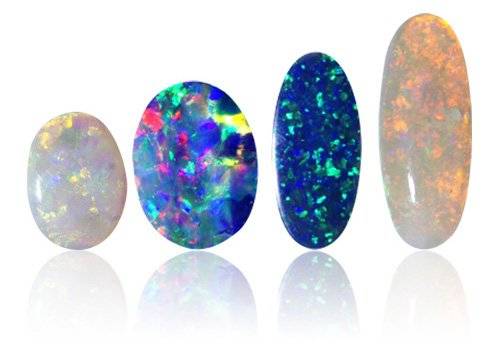Kinds of Opal
Opal is a notoriously difficult gemstone to mine. Unlike other gemstones, there are no opal veins. Neither does it concentrate like diamonds. Small quantities of opal are scattered over a wide area. Did you know that some varieties of opal are more precious than emeralds and rubies? Here are more details on the different types of opals.

Black opal
Black opals are very valuable because they are very rare. Their dark body tone of blue, brown, grey or even black distinguishes them from other kinds of opals. Most black opals contain rainbow colours, while some contain deep green and blue hues.
Semi-black opals are also found; the difference is, a black opal has a dark body with brilliant colours, whereas semi-black opals are mid-grey.
Boulder opal
Boulder opals are extracted from dark or light ironstone boulders. They are seen as thin veins in the rocks. Hydrated silica flowed into the cavities and cracks in the ironstone boulders millions of years ago and solidified over time. The silica will be fixed in a cavity or might be interspersed in the rock, hence the name 'boulder opals'.
One of the best known variety of boulder opals are Yowah-nuts. These are small ironstone concentrations, with solid opal kernels or thin opal veins.
Light opal
A light opal will have either a light blue or white base. All the colours of the rainbow may be visible in these opals. Some light opals are translucent and the sharp colours are visible just under the surface.
Doublet opal
Doublet opals are not actually solid opals. In this case, thin pieces (slices) of high quality opal (usually light opal) are glued to a backing of black potch (common opal), ironstone or even glass, to resemble a boulder opal or black opal.
Triplet opal
Triplet opals are also not solid opals and contain three layers. First, a thin piece of valuable opal is glued to a dark common opal or a darkened piece of porcelain or glass. The piece of opal is then given a protective cover by cementing a piece of clear quartz on it, with clear resin.
Common opal
Common opals or potch are not gems. There are many varieties of potch and most of them are opaque. Some of them are hyalite, hydrophane, resin opal and potch.
Opalised fossils
The opal fields in Australia were once covered by the sea. Where there is a sea, there will naturally be sea creatures. So from time to time opalized fossils are unearthed. Sea water contains silica, which enter the shells of the dead sea creatures. Over time, the water evaporates, leaving behind silica. Most opalized fossils are shells, but you can also find opalized wood, sponges, animal bones, plant stems and even fish skeletons.
Synthetic opals
Synthetic opals are created in laboratories. Chemically, they are not different from natural opals. Sometimes, synthetic opals are passed off as natural opals, so you have to be very careful when buying.


